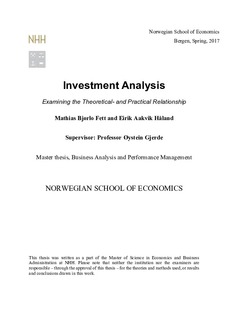| dc.description.abstract | Previous studies on the topic of theory versus practice are usually conducted using
surveys, with extensive questionnaires addressed to CEOs from different companies.
This give rise to aggregated results, primarily focusing on the different methods
companies use. As opposed to the survey approach, this thesis aims to investigate the
assumptions underlying the inputs and thereby capture a more detailed image on
theoretical and practical differences.
The purpose of this thesis is to provide a comprehensive- and in-detailed study of an
investment decision involving a wind farm project made by Company X. This specific
project is analyzed solely based on a theoretical approach in terms of methods and
assumptions. Moreover, the methods and assumptions applied by this thesis are
extensively discussed against the methods and assumptions made by Company X.
The power industry distinguished itself as being a unique industry in terms of vital
governmental subsidies and distinctive dynamics regarding the supply- and demand of
power. This contribute to the fact that decoupling from aggregated studies is a necessity
to conceive more relevant results.
The thesis finds that Company X’s investment analysis had a strong link with the
theoretical foundation, which was in contrast to our first assumption, that there would at
least be some significant gaps between the theoretical- and practical approach. However,
there are two findings that we find especially interesting.
First, the cost of capital estimated in this thesis is relatively lower than the utilized cost of
capital of Company X. This is not necessarily a breach between theory and practice, but
rather a matter of what relevant risk is considered to be. This correspond with findings
from other theory- and practice surveys - that many firms use the total firm risk rather than
project risk in assessing new investments. Second, the analytical results illustrate deviant
objectives in terms of reflecting the true project value. We observe a weak tendency
towards making the project as profitable as possible, as opposed to identifying the actual
value creation of the project. | nb_NO |
